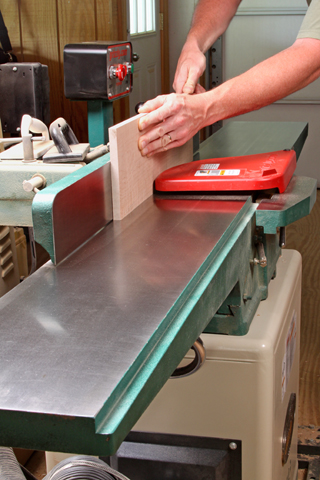
I have a question that popped into my head the other day while replacing my newly sharpened jointer knives. I have never read or learned of safety protocol relative to the length of stock to safely push across a jointer bed. What is the recommended maximum length board that should be passed through a jointer (taking into consideration the length of the jointer bed)? I am certain the width of the board plays into the equation, so please address that aspect, too. — Lenny Butler
Tim Inman: Great question! This is all about inertia and leverage. Little, short boards (sticks) are dangerous; little, short, wide boards are worse. You have virtually no leverage, and not much resistance to the forces of the cutterhead should something “grab” instead of shear cut. I don’t know of any rule about size, but here is what I do. On the top of my jointer fence, I have painted a bright orange stripe 12-inches long. If my wood isn’t longer than that, I don’t run it over the jointer. I also use a push plate or “pusher” that will cover smaller wood when I push across the jointer head. This not only makes me feel safer, it also keeps the wood nice and flat as well as in control throughout the cut. The “throat” or opening between the cutter knives and the edge of the table comes into play with this safety question, too. The greater the distance between the edge of the knife and the edge of the table, the greater the danger of a small piece catching and becoming a flying missile. This distance is adjustable in some better jointers, fixed in others. Long story shorter: Little boards and big powerful machines are trouble.
Chris Marshall: Tim makes some good points about minimum workpiece sizes on a jointer, so I’ll do the same for maximums. I don’t face-joint stock any wider than my jointer bed, which is 8 inches. Wider stock gets ripped first so it fits my machine, then I join the faces flat and re-glue the workpiece. If an overly wide board is really close to flat already and out of wind, I might head straight to the planer and make a couple of light passes to bring the first face closer to flat, but this is a rare exception. (Another option, of course, is to turn to hand planes as your flattening system; then you can forego the ripping and re-gluing solution entirely.) In terms of maximum stock length, it’s back to what Tim suggested but on the other end of the size spectrum: I don’t want to join a board longer than I can safely manage on my own or accurately flatten with the machine. As it seems to turn out, generally, I don’t need workpieces longer than about 6 feet unless I’m making a huge tabletop or a big faceframe. I don’t know that there’s a hard-and-fast rule about maximum proportions, but until I find it, I’ll let practicality and safety be my guides.







